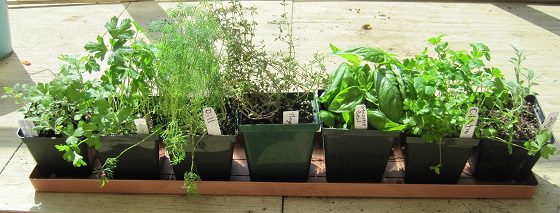Planting a Windowsill Herb Garden

A windowsill herb garden is a boon for any cook, infusing your cooking with taste and your kitchen with fragrance.
Growing herbs outside is easy during the summer, but what about the winter and spring?
There is no need to be without fresh herbs just because its cold outside, you can grow and harvest herbs indoors all winter long—or indeed, all year long if you so wish by planting a windowsill herb garden.
Happily, most herbs do well in containers and grow wonderfully with minimal fuss or care. However, there are some extra considerations when you grow herbs indoors.
So, how to set up a windowsill herb garden.
Firstly, decide where to grow your herbs.
A lack of adequate light will leave your herbs lanky, miserable and poor in flavour. The best place for your indoor herbs is on a sunny windowsill where they will receive maximum light. A south or southwest window is ideal. It is important your plants receive a minimum of six hours of natural sunlight per day, and it is also important that they are in a position that is free of cold drafts.
Choosing which Herbs to grow.
First, chose herbs that you like to use in your cooking or that you enjoy the fragrance of.
Secondly, chose herbs that are compact and will not easily outgrow their designated growing space.
If you buy perennial herbs for your windowsill herb garden, then you can alway move the plants out to the patio or even plant them in the garden in late spring.
If you are restricted to growing on your windowsill only, then there is still a wonderful range to chose from. Chives, basil, parsley, oregano mint, rosemary, sage and thyme are all good choices.
You can purchase nursery plants, (The Bare Acre Farm Shop always has a range of in seasonal herbs) or you might try growing your herbs from seed. Starting from seed is inexpensive, but it does require attention to detail and in most cases you will have to wait many months before you have a harvest from your herbs.

Containers for your Plants
If you are starting with nursery plants in 1 litre pots, then they should be fine for their first year. However, as they grow, it is worthwhile moving them to a larger container. Containers do not have to be huge, a pot 6 to 12 inches (30cm) wide and deep will do for most herbs depending on their mature size. You can have fun selecting suitable containers, I like containers that will accommodate multiple plants and like to mix plants to have contrast of foliage shape and colour as well as contrasting heights.
Which ever container you select, be sure it has sufficient drainage holes and remember to place a saucer or dish under your container to catch excess water at watering time
At Bare Acre Farm, we use a good quality organic potting mix that’s light and well-draining for all of our herbs.
If you are potting on, Don’t use soil from your garden as it is likely contain weed seeds or worse, pests and diseases, instead use a good quality compost and preferably one that is organic.
It is worth adding vermiculite and grit to your compost to enhance drainage and a little gravel (10mm layer) on top of the container will conserve moisture and enhance the look of your herb garden.
Caring for Your Windowsill Herb Garden
Not all Herb are the same, so make sure to check what your specific plants require. As a rule, herbs originate in warm regions, so they don’t like to sit in overly wet soil, in fact, the main reason for failure with herbs is over watering. (It is better to have your herbs a little dry than sapping wet)
When watering, water until the water starts to seep from the container drainage holes then stop. Check water weekly and never allow your containers to dry out completely.
Most herbs don’t require a lot of feeding. I limit the feeding of ours to a small dressing of pelleted poultry manure in spring, when serious growth begins, I seldom feed any more than a teaspoon full per plant, but if your plants look like they are stunted or are not thriving, give them a bit more. Remember, Herbs grow slowly in the winter and as a rule they need no feed during the colder months.
Harvesting Windowsill Herbs.
When you plant new herbs, give them a little time to settle in before you start snipping them. As a rule, it is a good idea to wait until you see new growth before you start harvesting with a scissors, this generally happens quickly outside of the very coldest months.
The majority of herbs are harvested by snipping 2 to 3 inches off their growing tips which allows you to harvest from them as the needs of your kitchen dictate. Regular harvesting encourages plants to become bushy and produce further.
For most annual herbs like parsley, dill, and coriander you should snip from the outside of the plants, and allow the central growing point to provide new growth, this will allow your plants to live longer and produce more. The exception to this is basil which is best harvested fro the top down, snipping of tips. (side-shoots will appear lower down the plant and provide additional ongoing harvest for several months)
Never snip more than a third of any plant’s foliage at any one time as such a heavy harvest can stress herb plants and leave then vulnerable to pests and diseases and in severe cases will send them into terminal decline.
Keeping it Fresh
Windowsill herbs are satisfying to grow but even the perennials will not last forever so it is worth renewing some of your plants every year or two to provide your self with an abundant supply of fresh, aromatic herbs that will enhance your cooking and liven up even the most humble of food.
Check out The Bare Acre Big Plant Stand for seasonal potted herbs.
